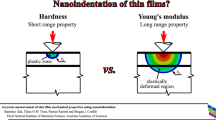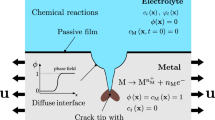Abstract
The average value of the crack tip stress intensity factor produced by a row of impurity atoms is calculated in this paper. The row of impurity atoms lies parallel to the crack front and is situated at an arbitrary position about a crack. The impurity atom produced mode I shielding/antishielding stress intensity factor L iI for a row of impurity atoms very close to the crack tip is given by the expression: 295-1 where 2a is the crack length, a * is either the atomic radius of the host atoms (for substitutional impurities) or the radius of the vacant interstitial site (for interstitial impurities), 295-2 and 295-3 where G is the shear modulus, c is the fraction of impurity atoms in the impurity atom row and ε is the misfit parameter of the impurity atoms, r 2 is the distance from the crack tip, and 295-4 is the angle the radius r 2 makes with the crack plane.
Résumé
On calcule dans ce travail la valeur moyenne du facteur d'intensité de contraintes occasionné par une rangée d'atomes étrangers, située parallèlement à un front the fissure, et en une position arbitraire par rapport à la fissure.
L'atome intersticiel ou de substitution génère une facteur d'intensité de contrainte de mode I, qui interfère sur une rangée d'atomes étrangers très proche de l'extrémité de la fissure, selon une expression ou interviennent la longueur de la fissure, le rayon atomique des atomes donnant lieu à une substitution ou à une insertion d'atomes étrangers, le module de cisaillement, la fraction d'atomes étrangers présents sur une rangée, le paramètre de désaxement des atomes étrangers, la distance de la rangée par rapport à l'extrémité de la fissure, et l'angle qui caractérise cette distance par rapport au plan de la fissure.
Similar content being viewed by others
References
A.R.Troiano, Transactions, American Society of Metals 52 (1960) 54.
A.K.Zurek and H.L.Marcus, in Hydrogen Effects in Metals, I.M.Bernstein and A.W.Thompson, eds., TMS-AIME, Warrendale, PA (1981) 57.
H.Rauh and R.Bullough, Proceedings, Royal Society, London 397 (1985) 121.
J.C.M.Li, R.A.Oriani and L.S.Darken, Zeitschrift fur Physikalische Chemie Neue Folge 49 (1966) 271.
J.E. Hack, Ph.D Thesis, University of Texas, Austin (July 1985).
F.C.Larche and J.W.Cahn, Acta Metallurgica 33 (1985) 331.
J.Weertman, International Journal of Fracture 26 (1984) 31–42.
J.Weertman and W.V.Green, in Irradiation Effects on the Microstructure and Properties of Metals, ASTM STP 611, Americal Society for Testing and Materials, Philadelphia (1976) 256.
Author information
Authors and Affiliations
Additional information
This research has been performed under the auspices of the U.S. Department of Energy.
Rights and permissions
About this article
Cite this article
Weertman, J., Hack, J.E. Stress intensity factors for crack tip shielding or anti-shielding by impurity atoms. Int J Fract 30, 295–299 (1986). https://doi.org/10.1007/BF00019709
Received:
Revised:
Issue Date:
DOI: https://doi.org/10.1007/BF00019709




